
 |
|
|
The Long Life of the Catenary:
From Brunelleschi to LaRouche by Bruce Director |
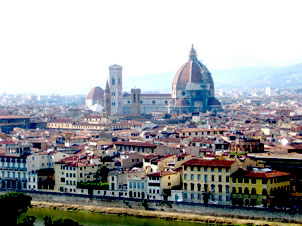 EIRNS/Dianne Bettag Cathedral of Santa Maria Del Fiore, Florence, Italy. |
The Long Life of the Catenary:
From Brunelleschi to LaRouche
by Bruce Director
To make the urgently needed shift from a consumer society to a producer one, requires a fundamental change in the way people think. The mind of the consumer knows the universe only through the objects that stimulate the senses, along with the magical powers he believes control them. When confronted with a crisis, such as the present one, consumers become frightened. They demand action from an increasingly impotent priesthood of financial advisors and opinion makers who, unable to boost consumer confidence, fail to produce results. As the crisis deepens, suspicions mount that the unseen potencies on whom they have relied, have either gone deaf, or departed the scene. Their ultimate terror, however, is the thought that such market forces might never have existed; thus, the idea of their previous existence persists, continuing to govern the thoughts and actions of the consuming public, and feeding an increasingly hopeless pessimism.
This was the state of affairs in Florence, Italy, when, following the collapse of the feudalist financial system, nearly 80 percent of the population perished from the Black Death between 1347 and 1350. The reactions of the population to that crisis are aptly described by the Florentine poet Giovanni Boccaccio, in the introduction to his Decameron. His countrymen, Boccaccio reports, had either fallen into a state of austere penitence, bacchanalian revelry, or some other form of “looking out for ‘number one’ ”:
Thus, adhering ever to their inhuman determination to shun the sick, as far as possible, they ordered their life. In this extremity of our city’s suffering and tribulation, the venerable authority of laws, human and divine, was abased, and all but totally dissolved for lack of those who should have administered and enforced them, most of whom, like the rest of the citizens, were either dead, or sick, or so hard-bested for servants that they were unable to execute any office, whereby every man was free to do what was right in his own eyes.
|
Figure 1
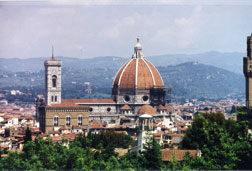 Cathedral of Santa Maria del Fiore, Florence, Italy Cathedral of Santa Maria del Fiore, Florence, Italy |
|
Figure 2
|
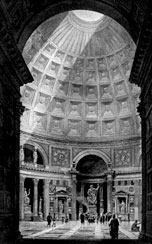 |
The Dome (Duomo) was a project of bold optimism. Unlike the Pantheon, the Florentine Dome was to be beautiful from both inside and out; a quality intended to counteract the persisting pantheonic culture that had brought about the calamity from which Europe was still reeling. Never before had such a large structure been vaulted by a self-supporting and free-standing dome. Its towering beauty would demonstrate a principle of both science and art, and, as such, would transform the entire surrounding region, and, [through travellers, the entire world.
The full implications of the principles necessary to construct the Dome were not known to its original designers; to accomplish the feat, Brunelleschi would have to discover, apply, and communicate a form of the universal principle of least-action, whose further elaboration would unfold over the ensuing 500 years. This process was advanced in 1988, when Lyndon LaRouche visited the Dome, and recognized the implications of Brunelleschi’s discoveries for the subsequent breakthroughs of Gottfried Leibniz, Carl Gauss, and Bernhard Riemann, and for the future development of a new physical science.1
The Dome and Anti-Euclidean Geometry
Imagine yourself in 1420, looking at the octagonal drum of Santa Maria del Fiore, without the dome. What do you see? Empty space? If so, you could never envision, let alone build the dome. The construction of the dome required a mastery of principles not visible to the eye. Not the invisible, magical powers of the Pantheon, but the universal physical principles which, though unseen, are known clearly through the imagination. For the scientist and artist alike, there is no such thing as empty space; no empty canvass, no blank slate. Indeed, there is a manifold of physical principles, characterized by a set of relationships whose expression ultimately takes the form of a work of art. To visualize the unbuilt dome, as the artist Brunelleschi would have, imagine the physical principles, and the bricks and mortar will assume their required form.
It is on this basis that we can begin to construct a physical geometry from the standpoint of Brunelleschi, Leibniz, Gauss, Riemann, and LaRouche. The roots of this physical geometry go back to the discoveries, in ancient Greece, of Thales, Pythagoras, Archytas, Plato, Menaechmus, Archimedes and Eratosthenes, all of whom—unlike the presentation provided by Euclid’s Elements—derived the principles of geometry from investigations of physical principles, not abstract notions of empty space.
From the time of the murder of Archimedes by Roman soldiers in 212 B.C.E. European thought had been dominated by Aristotle’s doctrine that universal principles have no effect on earthly affairs, and that knowledge of such principles is impossible. Consequently, human knowledge could only be based upon sense perceptions, or on propositions of an abstract geometry derived deductively from unprovable common axioms and opinions, which were separated from the physical world, just as, according to Aristotle, the heavens were separated from Earth. To build the Dome, Brunelleschi had to reject Aristoteleanism and return to the Platonic tradition of science, which understood that the physical world was governed by universal physical principles, and that, although unseen, the human mind possessed the power to discover and employ these principles to increase man’s power in and over the universe.
Physical Principles vs. Aristotle
To grasp this, examine some simple problems of building construction, in which the distinction between the physical principles of universal gravitation, and Aristotelean notions of abstract geometry, come to the fore. Start with a vertical column, which takes the shape of a line. An abstract geometrical line, according to Euclid, is that extension in empty space which has only length. No matter how long the line, its width is always the same, namely, nil. However, when building a vertical column (line) of bricks, the higher the column, the greater the weight (pressure) on the lower bricks. To build a taller column requires strengthening the lower portions of the column, by increasing the width at the base, or by some other means, such as buttressing the column externally.
|
Figure 3
|
|
Figure 4
|
At first thought, the circle appears to be the simplest type of arch, because the circular boundary encloses the largest area by the least perimeter. A relatively stable circular arch can be constructed, if the arch is designed so that all the bricks point to the center of the circle [See Figure 4]. However, while such an arch is under construction, it cannot support itself, and a temporary scaffolding is required to support it. Thus, the arch is self-supporting as a whole, but not in its parts.
|
Figure 5
|
|
Figure 6
|
|
Figure 7
|
|
Figure 8
|
But, no one had ever built a dome the size of the one proposed for Brunelleschi. Consequently, he had to design a structure whose shape would balance these stresses without requiring the external buttressing that would detract from the Dome’s beauty, and thus lessen its effectiveness in changing society by elevating the minds of the population.
Brunelleschi faced an additional problem. A dome, like an arch, generally requires a supporting scaffold, or centering, to hold it up while under construction. Here, Brunelleschi faced his most formidable obstacle. The dome proposed for Santa Maria del Fiore was so big, it exceeded the available wood to build the scaffolding. Brunelleschi shocked all his competitors, by making the unprecedented proposal to build the Dome without any centering at all. This bold step required him to design the dome so that it was self-supporting in both its whole and its parts. Such a shape could not be determined by the methods associated with Euclidean geometry; the shape Brunelleschi required could only be determined by physical principles.
Constructing the Dome
|
Figure 9
|
Since the use of centering had to be avoided, Brunelleschi had to control the shape of both domes very carefully as they were being constructed. This entailed controlling three different curvatures: the longitudinal curvature; the circumferential curvature; and the curvature inward towards the center of the dome. If all three curvatures could be controlled during all phases of construction, not only would the dome be stable upon completion, but each stage would be stable enough to be a platform from which the next stage could be built. This meant that the dome had to conform to a shape that would be self-supporting in both its whole and its parts.
|
Figure 10
|
|
Figure 11
|
Brunelleschi had to solve a multitude of problems, each requiring revolutionary new ideas. But the discovery most central to his success, the one most relevant for the future development of the anti-Euclidean physical geometry of Kepler, Fermat, Leibniz, Gauss and Riemann, is the one identified by LaRouche: the principle of the catenary.
The Principle of the Catenary
|
Figure 12
|
While this characteristic was known to the ancient Greeks, as well as to Brunelleschi, the principles underlying it were not fully elaborated until Gottfried Leibniz and Johann Bernoulli discovered them more than a century later. Using Leibniz’s calculus, they demonstrated that the catenary shape taken by the chain, was that shape which equalized the physical tension at every point [See Figure 13].
 |
Furthermore, Leibniz showed that this physical principle corresponded to the elementary transcendental functions; the circular, hyperbolic, and logarithmic [See Figure 14].
|
Figure 14
|
|
| Liebniz demonstrated that the physical principle discoverd by Bernoulli was expressed by the arithmetic mean between two curves which he called “logarithmic.” Liebnix described the constuction as follows: “Given an indefinite straight line ON parallel to the horizon, given also OA, a perpendicular segment equal to O3N, and on top of 3N, a vertical sgement 3N3ξ which has with OA the ratio of D to K, find the proportional mean 1N1ξ and 3N3ξ; then, in turn, find the proportional mean between 1N1ξ and OA; as we go on looking for second proportional means in this way, and from them third proportionjals, follow the curve 3ξ -1ξ-A-1(ξ)-3(ξ) in such a way that when you take the equal intervals 3N1N, 1NO, O1(N), 1(N)3(N), etc., the ordinates 3N3ξ 1N1ξ, OA, 1(N)1ξ, 3(N)3(ξ), are in a conatinuous geometric progression, touching the curve I usually identify as logarithmic. So, by taking ON and (N) as equal, levate over N and (N) the sgement s NC and (N) (C) equal to the semi-sum of Nξ (N) (ξ) such that (C and (C) will be tow points of the catenary curve FCA(C)L, on which you can determine geometrically as many points as you wish. |
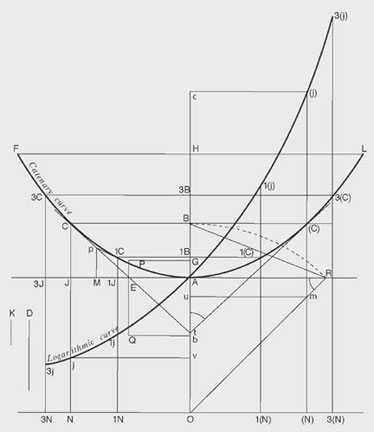 |
Look back at our earlier comparison of the difference between abstract geometrical notions of line, area, and volume, and the physical requirements of constructing a column, arch, and dome. As is already implicit in the concept of “powers” developed by Pythagoras, Archytas , Plato, et al., even the geometrical concepts of line, area, and volume are ultimately determined by the type of physical principles which Leibniz demonstrated are expressed by the catenary. The Aristotelean opinion that lines, areas, and volumes are abstract geometric entities separated from the universal physical principles that generate them, is as fallacious as the belief in the magical powers of the Roman pantheon.
Brunelleschi used a hanging chain to guide the development of the curvature of the Dome at each stage of construction. As each course of bricks was laid, a chain was hung between the intermediate ribs to guide the curvature. Thus, the overall shape of the Dome was determined, not by a curvature defined by abstract mathematics, but by a physically defined principle. Just as a hanging chain is self-supporting in its whole and its parts, the Dome, whose curvature was guided by the curvature of the hanging chain, is, likewise, a self-supporting surface, in its whole and its parts.
A word of caution is warranted to Aristoteleans who demand to “see” the physical shape of the catenary in the final shape of the Dome. Although Brunelleschi employed a form of the principle of least-action which Leibniz and Bernoulli later discovered was expressed by the catenary, the features of the Dome are not in the shape of a hanging chain. Rather, it is the principle of least-action expressed by the hanging chain, as that principle was later developed in Gauss’s theory of surfaces, Riemann’s theory of manifolds, and LaRouche’s principles of physical economy, which shaped the Dome. Writing in “Believing Is Not Necessarily Knowing,”3 LaRouche discusses his discovery:
This connection is illustrated with exemplary appropriateness by a case I have often referenced since 1988, the lesson to be adduced from Brunelleschi’s successful construction of the famous cupola of the Santa Maria del Fiore Cathedral of Florence. I continue to emphasize that example, not merely because I succeeded, during 1987-88, in rediscovering a principle which Brunelleschi had used, with his foreknowledge of its success, in effecting a process of construction which had been thought physically impossible. The principle he used to secure that success, was the same catenary principle which Leibniz, more than two centuries later, was first to identify as the expression of the universal principle of physical least action. Here, art and science were the same principle. The otherwise impossible process of construction so effected, was a demonstration of the principle of truth expressed equally as a principle of truth in the triumph of Christian Platonic science and art, over the false, pantheonic tradition and symbols of Latin Romanticism.The beauty of the Dome demonstrates the truth of Brunelleschi’s discovery, but it would take the discoveries of Kepler, Fermat, Leibniz, Gauss, Riemann, and LaRouche to fully grasp the underlying principle.Leibniz’s principle of least action, which is the basis for Leibniz’s discovery of natural logarithms, is expressed by the catenary function, which is the physical curve of “the hanging chain,” caused by physical action. This curve was reflected in ancient, pre-Roman Classical Greek sculpture as the principle of continuing motion caught in a midstream moment, as John Keats calls our attention to this equivalence of truth and beauty in his “Ode to a Grecian Urn.”
Once again: Truth is a matter of method! In this case, the cupola, truth as a method of art, and truth as uniquely a method of physical principle for successful construction, coincide. To succeed in sculpting a figure caught in mid-motion, the mind of the sculptor must feel the impact of what Leibniz defined as a universal physical principle of least action, just as Brunelleschi settled upon the use of the catenary, in the form of a hanging chain, a form of matter in motion even when it appears stilled, to enable the process of constructing the double wall of the cupola. The point was not that the finished cupola reflected the catenary form, but that the ability to construct those walls depended upon the principle of action expressed during each and every momentary phase of the ongoing process of construction of the still yet to be completed cupola.
The Development of the Physical Idea of Shape
The success of Brunelleschi’s Dome demonstrated that the architectural principles of physical geometry on which it was based, were universal. This view was expressed by Johannes Kepler, who approximately 150 years later wrote, in his Mysterium Cosmographicum, concerning the construction of the solar system,
We perceive how God, like one of our own architects, approached the task of constructing the universe with order and pattern, and laid out the individual parts accordingly, as if it were not art which imitated Nature, but God himself had looked to the mode of building of Man who was to be.Kepler went on to develop, in that work and in his subsequent New Astronomy and Harmonies of the World, that the shape of the solar system, like the Dome, was determined not by considerations of abstract mathematics (which would have indicated perfectly circular orbits), but by physically determined harmonic principles. Thus, the elliptical planetary orbits, like Brunelleschi’s Dome, were the size and shape that they had to be in order to express the harmonic relationships of those physical principles.
This physically determined idea of shape took another step in its development with Pierre de Fermat’s determination that the shape of the pathway of light was determined by the principle of shortest-time, as he wrote in “Method for Reaearch on Maximum and Minimum”:
Our demonstration is based on the single postulate, that Nature operates by the most easy and convenient methods and pathways—as it is in this way that we think the postulate should be stated, and not, as usually is done, by saying that Nature always operates by the shortest lines. ... We do not look for the shortest spaces or lines, but rather those that can be traversed in the easiest way, most conveniently and in the shortest time. [See Figure 15]
|
Figure 15
|
|
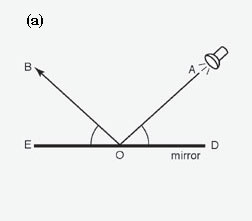 |
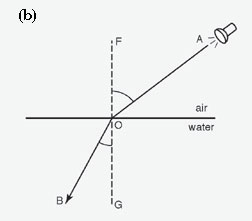 |
| (a) When light reflects off a mirror, the angle of incidence AOD and the angle of re | |
Leibniz, following up on the discoveries of Kepler and Fermat, generalized these discoveries as a universal principle of least-action in his Discourse on Metaphysics:
[T]he Architect of all things created light in such a way that this most beautiful result is born from its very nature. That is the reason why those who, like Descartes, reject the existence of Final Causes in Physics, commit a very big mistake, to say the least; because aside from revealing the wonders of divine wisdom, such final causes make us discover a very beautiful principle, along with the properties of such things whose intimate nature is not yet that clearly perceived by us, that we can have the power to explain them, and make use of their efficient causes, along with their artifacts, such as the Creator employed them in order to produce their results, and to determine their ends. It must be further understood from this that the meditations of the ancients on such matters are not to be taken lightly, as certain people think nowadays.
From Pathways to Surfaces
Brunelleschi’s Dome points the way to a still further development of the universal principle of least-action. Planetary orbits, the trajectory of light, and catenaries, are all pathways, i.e., curves. Brunelleschi’s Dome is a least-action surface.
The concepts needed to understand the implications of this distinction were developed by Gauss who, looking back (as we have been doing) on the discoveries of Kepler, Fermat, and Leibniz, developed the foundations of a physical theory of surfaces.
The context for Gauss’s discovery was his measurement of the surface of the Earth, which, because it is physically determined, must, in keeping with Leibniz’s principle, be a least-action surface. Over a more than 20-year period, Gauss made careful astronomical and geodetical measurements of the Earth. Abstract geometrical considerations would suggest that the Earth would be a perfect sphere, because the sphere encloses the largest volume inside the smallest surface. But, because the Earth is a rotating body in the solar system, its physical shape is not spherical, but ellipsoidal [See Figure 16].
|
Figure 16
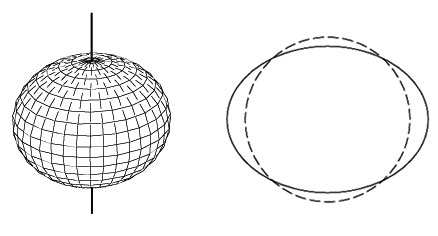 The Earth’s rotation on its axis causes it to bulge at the equator and flatten at the poles, forming an illipsoidal shape. The Earth’s rotation on its axis causes it to bulge at the equator and flatten at the poles, forming an illipsoidal shape. |
Gauss’s measurements, however, determined a discrepancy between the geometrical shape of an ellipsoid, and the physical shape of the Earth [See Figure 17].
|
Figure 17
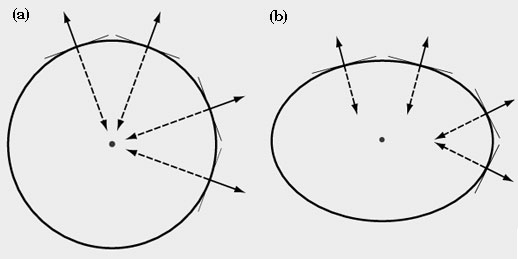 |
|
| To measure the shape of the Earth, geodesists compare changes in the angle of inclination of the north Star as seen from different points along the same meridian, with the distance measured along the surface between those same points. The angles of inclination of the North Star are measured with respect to the pull of gravity. (a) On a sphere, the direction of the pull of gravity is always toward the center of the sphere, and therefore equal changes in angle correspond to equal distances along the surface. (b) On an ellipsoid, the direction of the pull of gravity is not always toward the center. Consequently, equal changes in angle correspond to different distances along the surface. (c) By making very precise measurements, Gauss showed that the uneven distribution of the Earth’s land mass, caused the direction of the pull of gravity to change irrecularly from place to place. This led him to define the physical geometric shape that is today called the “Geoid.” |
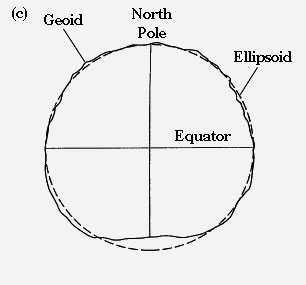 |
This led him to discover that the physical shape of the Earth was not that of an ellipsoid, but something more irregular. He identified the “geometrical shape of the Earth, as that shape which is everywhere perpendicular to the pull of gravity.” In other words, Gauss, like Leibniz earlier with respect to the catenary, did not try to fit the Earth into a shape pulled from the textbooks of abstract mathematics; rather, he invented a new geometry that conformed to the physical characteristics of the rotating Earth.
Gauss expanded this discovery into an extension of Leibniz’s principle of least-action. For Gauss, all surfaces had a characteristic curvature, which in turn determined certain least-action pathways, which he called “geodesics.” For example, in a plane, the geodesic is a straight-line, whereas on a sphere, the geodesic is a great circle. In these two cases, the curvature is uniform, and so the geodesic is the same everywhere on its surface. In contrast, an ellipsoid, for example, is a surface of non-uniform curvature. Consequently, the geodesic differs depending on its direction and position on the surface [See Figure 18].
|
Figure 18
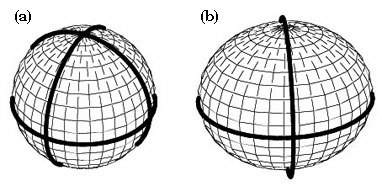 (a) The geodesic on a sphere is a great circle. (b) The geodesic on an ellipoid varies, depending upon direction and location. (a) The geodesic on a sphere is a great circle. (b) The geodesic on an ellipoid varies, depending upon direction and location. |
There is a further distinction between the plane and the sphere or ellipsoid. On the plane, there are an infinite number of pathways between any two points, but only one of these pathways is a geodesic, i.e., least-action. This is also true on a sphere or ellipsoid, except for the case when the two points are at the poles; then, there are an infinite number of geodesics between the two points. The bounded nature of the sphere and ellipsoid produces a singularity with respect to the nature of the geodesics.
Gauss investigated the general principles by which the curvature of the surface determined the characteristic of the geodesic. Of immediate relevance for this discussion, is Gauss’s determination of a means to measure the curvature of the surface at any point. It is sufficient for our purposes here to illustrate this by a physical demonstration. Draw a circle on the squash, by tying a marker to one end of a thread and rotating it, while holding the other end of the thread in a fixed position. The radii of this circle are all geodesics in different directions. Now, examine the curvature of each geodesic—they will vary for each direction. There will be one geodesic that is the least curved (minimum curvature), and another that is the most (maximum curvature). Try this a second time, on a different type of surface, such as a butternut squash shaped like a dumbbell. The round ends of the butternut squash have the same characteristic as the spaghetti squash, in that the center of curvature is always inside the squash; but, something different happens in the middle part, between the ends of the squash. Here, the center of curvature may be either inside or outside the squash, depending upon the direction of the geodesic. Gauss called this characteristic “negative curvature”; it is the characteristic of curvature expressed by a surface formed, for instance, by a rotated catenary, which is called a catenoid [See Figure 19].
|
Figure 19
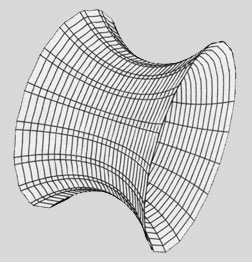 A negatively curved surface is one in which the centers of minimum and maximum curvature are on different siges of the surface. An example of such a surface is formed by rotation a catenary to form a “catenoid.” |
Thus, the curvature of the surface expresses a physical principle that in turn determines the geodesic, or least-action pathway along that surface. In the case of Brunelleschi’s Dome, it was the overall, physically determined shape of the surface of the Dome, which determined the characteristic curvatures, longitudinally, circumferentially, and inward. Yet, while under construction, that overall shape—which was yet to be—had to be formed from the small changes in the longitudinal, circumferential, and inward curvatures. Brunelleschi’s use of the hanging chain to guide these changes of curvature in the small, expresses the congruence between the catenary principle, and the least-action characteristics of the Dome.
From Surfaces to Manifolds
Working from Gauss’s discovery, Bernhard Riemann generalized the concept still further, to the idea of a geodesic within a manifold of universal physical principles. These manifolds having more “dimensions” than surfaces, cannot be directly visualized; but, like surfaces, their characteristics can be directly known by a change in geodesic.
For example, light under reflection and refraction follows a pathway within a surface, but either type of action expresses a different pathway, because the physical manifold of refraction includes a principle—changing speed of light—that does not exist within the manifold of reflection. The addition of this new principle to the manifold of action, changes the geodesic. Inversely, when a change is measured in the geodesic, it indicates the presence of a new physical principle in the manifold.
Riemann developed the means to represent these higher manifolds by complex functions, which he expressed metaphorically as surfaces. For example, the conic-section planetary orbits and the catenary are both least-action pathways with respect to the manifold of universal gravitation. Each represents a geodesic with respect to the manifold of universal gravitation. But, this poses a paradox: Why does the manifold of universal gravitation express two different types of geodesics, conic sections for planetary orbits, and catenaries for hanging chains? When the catenary principle is expressed as a function in the Gauss/Riemann complex domain, however, the conic section orbits are seen as a subsumed geodesic within the higher principle represented by the catenary [See Figure 20].
|
Figure 20
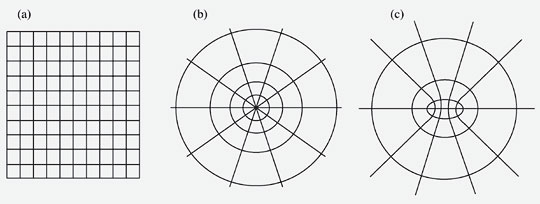 Riemann extended Gauss’s idea of surfaces to a more general concept of manifold. These manifolds could be investigated by studying the way in which geodesics changed when new principles were added. (a) An orthogonal grid of equally spaced straight-line geodesics of a plane. (b) In the transformation shown, the straight lnes have been transformed into an orthogonal grid of circles and radii: The equally spaced vertical lines become geometrically spaced circles, and the equally spaced horizontal lines becomed radii separated by equal angels. (c) When Leibniz’s concept of the catenary is applied, a network of ellipses and hyperbolas is produced. |
More general examples are illustrated in the accompanying figures [See Figure 21].
|
Figure 21
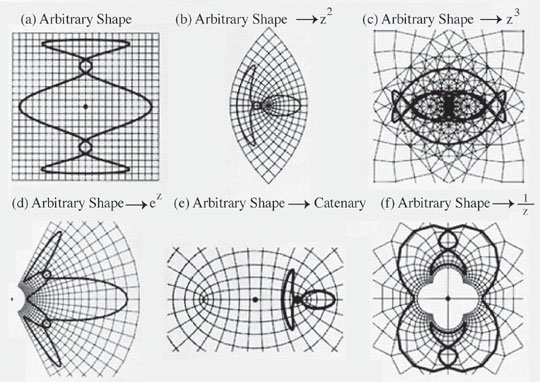 Examples of Riemann mappings. Here an arbitrary loopy curve is seen with respect to a manifold of changing geodesic. The curve maintains the same angel with respect to the geodesics, as the geodesics change from (a) straight-lines, to (b) parabolas, to (c) cubic curves, to (d) circles, and radii, to (e) ellipses and hyperbolas, to (f) inversiions. With each transformation of the manifold, the action represented by the curve changes. |
These illustrate how the same action, when carried out in different manifolds, is changed by the characteristics of the manifold. Think of the orthogonal nets in each figure as the minimum and maximum geodesics in each manifold. In each case, the loopy curve maintains the same angular orientation with respect to these geodesics. But, because the geodesics change from manifold to manifold, the action changes. Thus, a change in the principles that determine the manifold, changes the geodesics, which in turn changes all action within that manifold. Inversely, to effect a change in any physical action, one must act to change the characteristics of the manifold in which that action occurs.
Now look at Brunelleschi’s Dome from this standpoint. The Dome is a surface whose geodesic, in principle, conforms to the catenary. As a least-action surface, it expresses a geodesic with respect to the principle of universal gravitation. With respect to the manifold of universal history, building the Dome was the geodesic from that dying culture of the Roman Empire, to the Fifteenth-century Golden Renaissance.
At our present place in the manifold of universal history, building LaRouche’s “combat university on wheels” youth movement, and making LaRouche President of the United States, is for us, Brunelleschi’s Dome—the geodesic from today’s looming Dark Age, to a new Renaissance that never ends.
—Bruce Director
Notes:
1. See Nora Hamerman and Claudio Rossi, “Brunelleschi’s Dome: The Apollo Project of the Golden Renaissance,” 21st Century Science & Technology, July-August 1989 (Vol. 2, No. 4).
2. Ibid.
3. Lyndon H. LaRouche, Jr., “Believing Is Not Necessary Knowing,” Executive Intelligence Review, Jan. 17, 2003 (Vol. 30, No. 2).
![]()
schiller@schillerinstitute.org
The Schiller Institute
PO BOX 20244
Washington, DC 20041-0244
703-297-8368
Thank you for supporting the Schiller Institute. Your membership and contributions enable us to publish FIDELIO Magazine, and to sponsor concerts, conferences, and other activities which represent critical interventions into the policy making and cultural life of the nation and the world.
Contributions and memberships are not tax-deductible.
VISIT THESE OTHER PAGES:
Home | Search | About | Fidelio | Economy | Strategy | The LaRouche Frameup | Conferences
Links | LaRouche | Music | Join | Books | Concerts | Highlights | Education |
Health | Spanish Pages | Poetry | Dialogue of Cultures
Maps | What's New
© Copyright Schiller Institute, Inc. 2006. All Rights Reserved.

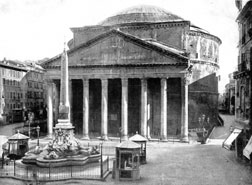
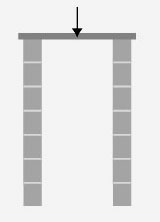 Enclosing a vertical area with columns and a flat roof. The roof is strong only close to ther columns, It is weak in the middle.
Enclosing a vertical area with columns and a flat roof. The roof is strong only close to ther columns, It is weak in the middle.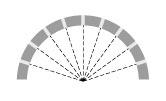 In a circular arch, the bricks all point to the center of the semicircle.
In a circular arch, the bricks all point to the center of the semicircle.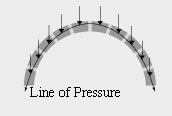 In a circular arch, the downward pull of gravity on the bricks does not correspond to the line of pressure along the arch. Consequently, the top tends to fall in, and the side push out.
In a circular arch, the downward pull of gravity on the bricks does not correspond to the line of pressure along the arch. Consequently, the top tends to fall in, and the side push out.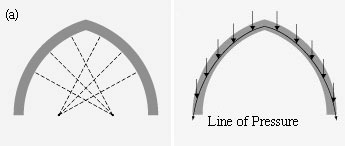 (a) In a pointed arch, each side is an arc of a circle, but the centers of the arcs are different. This makes the pointed arch taller than the corresponding circular one. (b) In a pointed arch, the downward pull of gravity conforms more colosely to the line of pressurel, distributiong the stresses along the arch into the ground.
(a) In a pointed arch, each side is an arc of a circle, but the centers of the arcs are different. This makes the pointed arch taller than the corresponding circular one. (b) In a pointed arch, the downward pull of gravity conforms more colosely to the line of pressurel, distributiong the stresses along the arch into the ground..jpg) Archytas demonstrated that thesolution to the problem of doubling the cube, or finding tow geometirc means between two extremes, cound be sol,ved by the intesection of a cylinder, torus, and cone.
Archytas demonstrated that thesolution to the problem of doubling the cube, or finding tow geometirc means between two extremes, cound be sol,ved by the intesection of a cylinder, torus, and cone.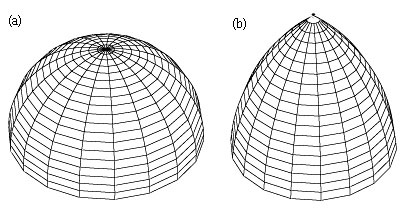 (a) A hemispherical dome is formed by rotating a circular arch. (b) A point dome is formed by ratationg a pointed arch. In physical structures, domes, unlike arches, have both longitudinal stresses from top to bottom, and circumferenctial (or hoop) stresses around the domes..
(a) A hemispherical dome is formed by rotating a circular arch. (b) A point dome is formed by ratationg a pointed arch. In physical structures, domes, unlike arches, have both longitudinal stresses from top to bottom, and circumferenctial (or hoop) stresses around the domes.. 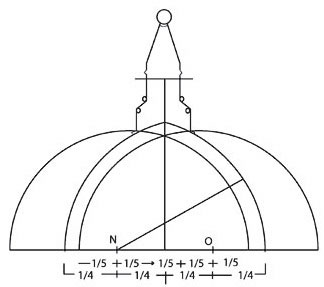 The plans called for the Dome to be poined. According to the architect Lando Bartoli, the centers of curvature of both the inner and outer dome are the same (point N). However, the radius of curvature of the inner dome is 4/5 the inner diameter (pointed-fifth) while the radius of curvature of the outer dome is 3/4 the outer diameter (pointed-fourth).
The plans called for the Dome to be poined. According to the architect Lando Bartoli, the centers of curvature of both the inner and outer dome are the same (point N). However, the radius of curvature of the inner dome is 4/5 the inner diameter (pointed-fifth) while the radius of curvature of the outer dome is 3/4 the outer diameter (pointed-fourth). 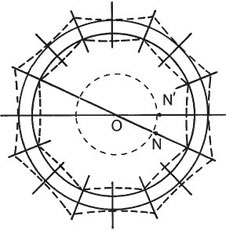 All the cneters of curvature for both the inner and outer domes lie on the same circle N N′ with center O. (Ground plan by Claudio Rossi after Lando Bartoli.)
All the cneters of curvature for both the inner and outer domes lie on the same circle N N′ with center O. (Ground plan by Claudio Rossi after Lando Bartoli.)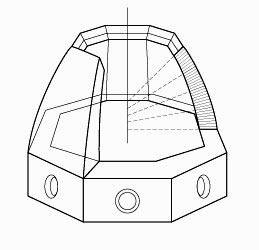 All the centers of each (approximately circular) course of bricks lie on the same line running from the lantern through the center of the drum. Each course of bricks angels inward at an increasingly steep angle.
All the centers of each (approximately circular) course of bricks lie on the same line running from the lantern through the center of the drum. Each course of bricks angels inward at an increasingly steep angle. 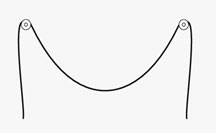 The catenary is the shape formed by a chain of uniform thickness hanging under its own weigh. When a chain is hung on pulleys so it can move freely, the only curve along which the chain is stable will be a catenary.
The catenary is the shape formed by a chain of uniform thickness hanging under its own weigh. When a chain is hung on pulleys so it can move freely, the only curve along which the chain is stable will be a catenary.